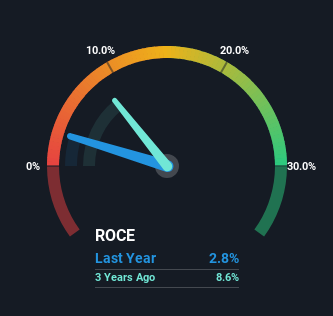- United States
- /
- Food and Staples Retail
- /
- NYSE:UNFI
United Natural Foods' (NYSE:UNFI) Returns On Capital Not Reflecting Well On The Business

If we're looking to avoid a business that is in decline, what are the trends that can warn us ahead of time? A business that's potentially in decline often shows two trends, a return on capital employed (ROCE) that's declining, and a base of capital employed that's also declining. Basically the company is earning less on its investments and it is also reducing its total assets. And from a first read, things don't look too good at United Natural Foods (NYSE:UNFI), so let's see why.
What Is Return On Capital Employed (ROCE)?
For those that aren't sure what ROCE is, it measures the amount of pre-tax profits a company can generate from the capital employed in its business. To calculate this metric for United Natural Foods, this is the formula:
Return on Capital Employed = Earnings Before Interest and Tax (EBIT) ÷ (Total Assets - Current Liabilities)
0.028 = US$147m ÷ (US$7.5b - US$2.4b) (Based on the trailing twelve months to August 2024).
So, United Natural Foods has an ROCE of 2.8%. In absolute terms, that's a low return and it also under-performs the Consumer Retailing industry average of 9.5%.
Check out our latest analysis for United Natural Foods

Above you can see how the current ROCE for United Natural Foods compares to its prior returns on capital, but there's only so much you can tell from the past. If you'd like, you can check out the forecasts from the analysts covering United Natural Foods for free.
What Does the ROCE Trend For United Natural Foods Tell Us?
In terms of United Natural Foods' historical ROCE movements, the trend doesn't inspire confidence. About five years ago, returns on capital were 5.5%, however they're now substantially lower than that as we saw above. On top of that, it's worth noting that the amount of capital employed within the business has remained relatively steady. Since returns are falling and the business has the same amount of assets employed, this can suggest it's a mature business that hasn't had much growth in the last five years. If these trends continue, we wouldn't expect United Natural Foods to turn into a multi-bagger.
The Bottom Line On United Natural Foods' ROCE
In the end, the trend of lower returns on the same amount of capital isn't typically an indication that we're looking at a growth stock. Yet despite these poor fundamentals, the stock has gained a huge 167% over the last five years, so investors appear very optimistic. Regardless, we don't feel too comfortable with the fundamentals so we'd be steering clear of this stock for now.
United Natural Foods does have some risks, we noticed 2 warning signs (and 1 which is a bit concerning) we think you should know about.
If you want to search for solid companies with great earnings, check out this free list of companies with good balance sheets and impressive returns on equity.
If you're looking to trade United Natural Foods, open an account with the lowest-cost platform trusted by professionals, Interactive Brokers.
With clients in over 200 countries and territories, and access to 160 markets, IBKR lets you trade stocks, options, futures, forex, bonds and funds from a single integrated account.
Enjoy no hidden fees, no account minimums, and FX conversion rates as low as 0.03%, far better than what most brokers offer.
Sponsored ContentNew: AI Stock Screener & Alerts
Our new AI Stock Screener scans the market every day to uncover opportunities.
• Dividend Powerhouses (3%+ Yield)
• Undervalued Small Caps with Insider Buying
• High growth Tech and AI Companies
Or build your own from over 50 metrics.
Have feedback on this article? Concerned about the content? Get in touch with us directly. Alternatively, email editorial-team (at) simplywallst.com.
This article by Simply Wall St is general in nature. We provide commentary based on historical data and analyst forecasts only using an unbiased methodology and our articles are not intended to be financial advice. It does not constitute a recommendation to buy or sell any stock, and does not take account of your objectives, or your financial situation. We aim to bring you long-term focused analysis driven by fundamental data. Note that our analysis may not factor in the latest price-sensitive company announcements or qualitative material. Simply Wall St has no position in any stocks mentioned.
About NYSE:UNFI
United Natural Foods
Distributes natural, organic, specialty, produce, and conventional grocery and non-food products in the United States and Canada.
Undervalued with moderate growth potential.
Similar Companies
Market Insights
Community Narratives


